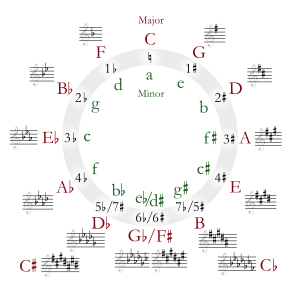E-flat major facts for kids
 |
||
| Relative key | C minor | |
|---|---|---|
| Parallel key | E♭ minor | |
| Notes in this scale | ||
| E♭, F, G, A♭, B♭, C, D, E♭ | ||
E♭ major is a musical major scale that starts on the note E♭. Its key signature has three flats.
Every major scale has a "relative minor" scale. For E♭ major, its relative minor is C minor. It also has a "parallel minor" scale, which starts on the same note but has a different sound. The parallel minor for E♭ major is E♭ minor.
Scales and keys
Music uses different scales and keys to create melodies and harmonies. A scale is a set of musical notes ordered by pitch. A key is a group of notes that form the basic foundation of a piece of music.
What is E-flat major?
The E-flat major scale is made up of these notes: E♭, F, G, A♭, B♭, C, and D. When you play these notes in order, they create the distinct sound of the E-flat major key.
Why are key signatures important?
A key signature tells you which notes in a piece of music will be played higher or lower than their natural pitch. For E-flat major, the key signature has three flats: B♭, E♭, and A♭. This means that whenever you see a B, E, or A note in a song written in E-flat major, you should play it as a flat note, unless there's a special sign to change it.
| Diatonic Scales and Keys | |||||||||||||||||||||||||||||||||||||||||||||||||||||||
|---|---|---|---|---|---|---|---|---|---|---|---|---|---|---|---|---|---|---|---|---|---|---|---|---|---|---|---|---|---|---|---|---|---|---|---|---|---|---|---|---|---|---|---|---|---|---|---|---|---|---|---|---|---|---|---|
|
|||||||||||||||||||||||||||||||||||||||||||||||||||||||
| The table shows the number of sharps or flats in each scale. Minor scales are written in lower case. | |||||||||||||||||||||||||||||||||||||||||||||||||||||||
See also
 In Spanish: Mi bemol mayor para niños
In Spanish: Mi bemol mayor para niños


